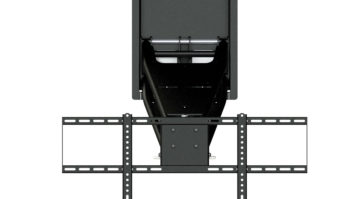After the electronics, perhaps the foremost consideration in a home theater is the seating. It could be argued that unless you’re offering your clients theater seating, you’re not a “total theater solutions provider.” So why have some custom and specialty A/V dealers embraced the home theater-seating sale, while others are still struggling with it?
Selling home theater seating can be a good way for custom and specialty A/V dealers to create additional revenues with substantial bottom-line profitability with every home theater sale. According to market data provided by Premiere Home Theatre Surroundings and Frost and Sullivan’s market study for CEDIA, the dedicated home theater seating category represented $20 million in sales in 2000 and rose to roughly $31.2 million in 2001. Sales are expected to increase to more than $45 million for 2002. According to Premiere vice president of marketing, Bill Johnson, dealer profit margins for dedicated home theater seating can be as high as 50 to 60 points.
Projectors, screens, electronics and speakers are often all hidden within the home. Often, theater seating is the only truly visible, physical attribute to the room that says, “it’s a dedicated home theater.” There were 1,800 dedicated high-end home theaters built in 2001 with an estimated increase to 2,300 in 2002. There is also a growing demand for “home entertainment rooms,” a multi-purpose room combined with a dedicated theater venue. Many of these rooms represent significant additional theater seating opportunities. Seating can also be sold to a dealer’s existing client base, without spending extra marketing money to generate new customers for this category. Keith Starkman is co-owner of East End Audio/Video, in Southampton New York. Located in Long Island’s affluent South Fork area, his company generates about $1.5 million annually in home theater sales. The average retail price of the home theaters they design is $25,000, but Starkman admits “confusion” related to selling the seating category.
“We know that we don’t want to leave money on the table by not making the seating sale,” he explained. “We have a dedicated 16 x 22-foot showroom that features a front-projection home theater system. For the past three years, we have been displaying several CinemaTech seats in our showroom, which is a great product. Yet, because we are the middle dealer in the territory, and even though we are in the Hamptons, people aren’t purchasing $3,500 seating from us. The only seats that I have sold are from a low-end seating vendor in the $1,000-$1,500 retail price range–primarily for secondary seat applications.”
Another issue concerning Starkman is that the vast majority of his company’s work is through general contractors, where his company is considered a subcontractor along with interior designers, who happen to make part of their living by providing the furniture.
“If I get called to a job by an interior designer or decorator, how can I sell furniture without it conflicting with the team?” Starkman asked. “I’ve been brought in to sell electronics by the people that are selling the furniture. The team concept is very strong out here in Southampton. All three A/V dealers in town co-exist because we all have our builders and all our own teams. Nobody crosses lines out here.”
Specialty A/V retailer Sound City, located in Denville, New Jersey (see Cover Story), also has extensive experience working with interior designers. The firm’s director of sales and home theater designer, Stephen Plafcan, feels that the interior designer is a welcome part of Sound City’s business.
“Working with the interior designer can be difficult, but you have to look at the entire picture,” he said. “Anybody who is interested in the end-result, and makes you proud of it, is a welcome part of the business.”
Sound City’s president and CEO, Kamel Yassin, added, “If you work well with the designers, they will bring you referrals and you will make a lot of money. If you fight with them, you will not be recommended. It is as simple as that.”
Starkman says most of his clients feel that home theater seats in the $1,000-$1,500 price range are not comfortable, at least when a customer must sit in them for a three-hour movie. Therefore, it is not uncommon for his client’s main seating to be a traditional Laz-E-Boy-type recliner or sofa. He then sells home theater seating for either secondary rows or side rows, just to give the room that “home theater look.” The majority of East End Audio/Video’s home theater seat sales are either single seats or in rows, Starkman said. Sound City has a different outlook on selling home theater seating. A much larger operation, their retail storefront location has several dedicated home theater and media demonstration rooms equipped with Premiere Home Theatre Surrounding’s seats, with additional seating displayed on their main sales floor. Yassin believes that home theater seating basically sells itself to his typical home theater customer. “A retailer has to put the chairs on the floor and not worry about what it costs, because it is a good investment,” he said. “When the customer touches it, sees it, feels it, and sits in it, they will love it. A retail price of $1,800 or $2,500 per chair is not really a lot of money when you consider it is a piece of furniture that will last in their home for a long time.”
Yassin also suggests that the advent of dedicated home theater seating has actually helped further both the concept and sales of home theaters. “How could you demo a room without them?” he asked. “Back in 1991, I designed my first home theater demo rooms with Irwin Seating and red commercial drapery because that’s what theaters were supposed to look like. But the seats didn’t recline; you had to sit upright. Since then, we’ve come a long way. These seats enhance lifestyle by incorporating such luxuries as reclining mechanisms and cup holders. Now you can really enjoy your movie in style. Without this kind of seating, the whole home theater concept is lost.”
Starkman would like to sell more home theater seats, but he doesn’t know which vendor to select. He feels it is much easier to choose an audio or video line than a seating line. He attended last year’s CEDIA show and was dizzied by all the different home theater seating companies displaying on the show floor. He wants reassurance that whichever seating vendor he selects will best support him and his customers.
“We hear the pitches from these seating companies about the construction of the seat, the guarantee, but we are not furniture guys,” Starkman said. “Our experience has been in audio and video products. I don’t know them like I know audio companies that have been around for 20 years. Who do you trust? What happens when the chair gets delivered and it has a tear? We have demanding customers that expect incredible service from me.”
Bill Johnson of Premiere offered the following advice for dealers interested in entering the dedicated home theater seating category: “It helps to work with a manufacturer who has vast experience in helping the A/V dealer to be successful in the category. The theater-seating sale has become a truly collaborative sale. The manufacturer should be willing to work with the dealer, the decorator and the client to ensure that the end result is perfect.”
He further cautioned, “We are reluctant to recommend to any specialty retailer that they run out and jump into the theater seating “pool” unless they are willing to make a serious commitment to the category.” The cable category and the plasma TV category are great examples of how some specialty dealers first failed and then learned how to sell the category, Johnson noted.”This means aligning critical elements such as ordering the right product mix based on the dealers profile and their target customer profile, merchandising it to make a statement that the dealer is clearly a player in the category and training their sales staff to consistently and effectively present it to their clients,” he said. “It isn’t rocket science; it’s Marketing 101. But if the dealer is willing to implement these critical steps, there are plenty of success stories out there that can attest to the value of being in the home theater seating business. And anything that can help the custom home theater specialist dealer to expand their “total solutions” image, increase customer satisfaction and loyalty, while adding substantial profitability to their business, warrants serious consideration.”
Most manufacturers and seasoned dealers agree that it’s important to learn as much as you can about the seating, before selling it. A number of seating manufacturers offer training programs for their products. The more you know, the more comfortable you will be selling their products. Theater seating should be approached just as any other product line that a dealer carries. It’s a specialized product, but one that should not be overlooked. Your customers are going to buy their seating somewhere. Why let them go someplace else?
Paul Muto is the president of Muto Communications, a Long Island-based public relations and marketing consulting firm specializing in consumer electronics technologies.







